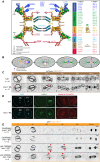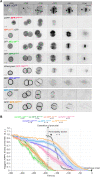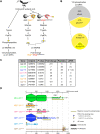Mechanisms of nuclear pore complex disassembly by the mitotic Polo-like kinase 1 (PLK-1) in C. elegans embryos
- PMID: 37467327
- PMCID: PMC10355831
- DOI: 10.1126/sciadv.adf7826
Mechanisms of nuclear pore complex disassembly by the mitotic Polo-like kinase 1 (PLK-1) in C. elegans embryos
Abstract
The nuclear envelope, which protects and organizes the genome, is dismantled during mitosis. In the Caenorhabditis elegans zygote, nuclear envelope breakdown (NEBD) of the parental pronuclei is spatially and temporally regulated during mitosis to promote the unification of the maternal and paternal genomes. Nuclear pore complex (NPC) disassembly is a decisive step of NEBD, essential for nuclear permeabilization. By combining live imaging, biochemistry, and phosphoproteomics, we show that NPC disassembly is a stepwise process that involves Polo-like kinase 1 (PLK-1)-dependent and -independent steps. PLK-1 targets multiple NPC subcomplexes, including the cytoplasmic filaments, central channel, and inner ring. PLK-1 is recruited to and phosphorylates intrinsically disordered regions (IDRs) of several multivalent linker nucleoporins. Notably, although the phosphosites are not conserved between human and C. elegans nucleoporins, they are located in IDRs in both species. Our results suggest that targeting IDRs of multivalent linker nucleoporins is an evolutionarily conserved driver of NPC disassembly during mitosis.
Figures







Update of
-
Mechanisms of Nuclear Pore Complex disassembly by the mitotic Polo-Like Kinase 1 (PLK-1) in C. elegans embryos.bioRxiv [Preprint]. 2023 Feb 22:2023.02.21.528438. doi: 10.1101/2023.02.21.528438. bioRxiv. 2023. Update in: Sci Adv. 2023 Jul 21;9(29):eadf7826. doi: 10.1126/sciadv.adf7826. PMID: 36865292 Free PMC article. Updated. Preprint.
Similar articles
-
Mechanisms of Nuclear Pore Complex disassembly by the mitotic Polo-Like Kinase 1 (PLK-1) in C. elegans embryos.bioRxiv [Preprint]. 2023 Feb 22:2023.02.21.528438. doi: 10.1101/2023.02.21.528438. bioRxiv. 2023. Update in: Sci Adv. 2023 Jul 21;9(29):eadf7826. doi: 10.1126/sciadv.adf7826. PMID: 36865292 Free PMC article. Updated. Preprint.
-
Channel Nucleoporins Recruit PLK-1 to Nuclear Pore Complexes to Direct Nuclear Envelope Breakdown in C. elegans.Dev Cell. 2017 Oct 23;43(2):157-171.e7. doi: 10.1016/j.devcel.2017.09.019. Dev Cell. 2017. PMID: 29065307 Free PMC article.
-
Mitotic Disassembly of Nuclear Pore Complexes Involves CDK1- and PLK1-Mediated Phosphorylation of Key Interconnecting Nucleoporins.Dev Cell. 2017 Oct 23;43(2):141-156.e7. doi: 10.1016/j.devcel.2017.08.020. Dev Cell. 2017. PMID: 29065306 Free PMC article.
-
What can Caenorhabditis elegans tell us about the nuclear envelope?FEBS Lett. 2007 Jun 19;581(15):2794-801. doi: 10.1016/j.febslet.2007.03.052. Epub 2007 Mar 30. FEBS Lett. 2007. PMID: 17418822 Review.
-
From pore to kinetochore and back: regulating envelope assembly.Dev Cell. 2006 Sep;11(3):276-8. doi: 10.1016/j.devcel.2006.08.005. Dev Cell. 2006. PMID: 16950119 Review.
Cited by
-
Sculpting nuclear envelope identity from the endoplasmic reticulum during the cell cycle.Nucleus. 2024 Dec;15(1):2299632. doi: 10.1080/19491034.2023.2299632. Epub 2024 Jan 18. Nucleus. 2024. PMID: 38238284 Free PMC article. Review.
-
The MAST kinase KIN-4 carries out mitotic entry functions of Greatwall in C. elegans.EMBO J. 2025 Apr;44(7):1943-1974. doi: 10.1038/s44318-025-00364-w. Epub 2025 Feb 17. EMBO J. 2025. PMID: 39962268 Free PMC article.
-
PLK1 inhibition delays mitotic entry revealing changes to the phosphoproteome of mammalian cells early in division.EMBO J. 2025 Apr;44(7):1891-1920. doi: 10.1038/s44318-025-00400-9. Epub 2025 Mar 3. EMBO J. 2025. PMID: 40033019 Free PMC article.
-
Nucleoporin PNET1 coordinates mitotic nuclear pore complex dynamics for rapid cell division.Nat Plants. 2025 Feb;11(2):295-308. doi: 10.1038/s41477-025-01908-y. Epub 2025 Jan 31. Nat Plants. 2025. PMID: 39890949 Free PMC article.
-
An interkinetic envelope surrounds chromosomes between meiosis I and II in C. elegans oocytes.J Cell Biol. 2025 Mar 3;224(3):e202403125. doi: 10.1083/jcb.202403125. Epub 2024 Dec 26. J Cell Biol. 2025. PMID: 39724138 Free PMC article.
References
-
- L. Champion, M. I. Linder, U. Kutay, Cellular reorganization during mitotic entry. Trends Cell Biol. 27, 26–41 (2017). - PubMed
-
- P. De Magistris, W. Antonin, The dynamic nature of the nuclear envelope. Curr. Biol. 28, R487–R497 (2018). - PubMed
-
- B. Hampoelz, A. Andres-Pons, P. Kastritis, M. Beck, Structure and assembly of the nuclear pore complex. Annu. Rev. Biophys. 48, 515–536 (2019). - PubMed
Publication types
MeSH terms
Substances
Grants and funding
LinkOut - more resources
Full Text Sources
Research Materials
Miscellaneous

